Indra Nooyi: Of Wit, Wisdom, and Purpose
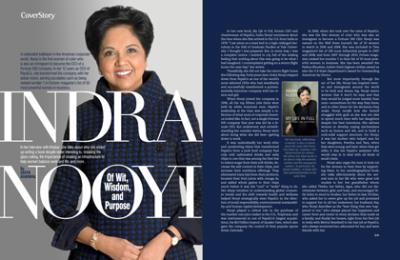
A celebrated trailblazer in the American corporate world, Nooyi is the first woman of color who is also an immigrant to become the CEO of a Fortune 500 company. In her 12 years as CEO of PepsiCo, she transformed the company with her astute vision, earning accolades such as being ranked number 1 in Fortune magazine’s list of 50 most powerful women in business.
In her interview with Khabar, she talks about why she ended up writing a book despite never intending to, breaking the glass ceiling, the importance of creating an infrastructure to help women balance work and life, and more.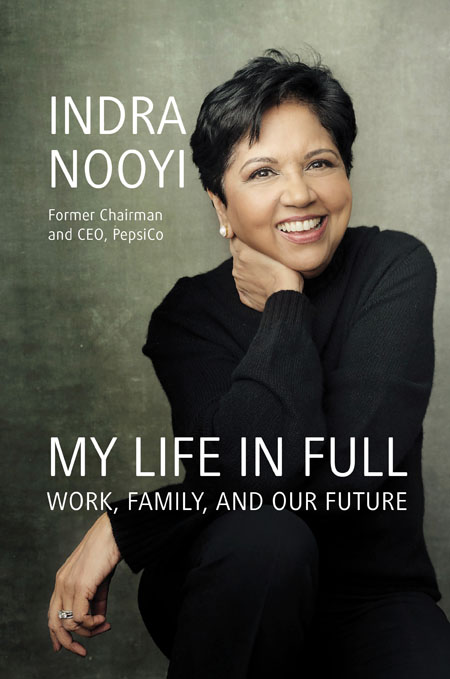
In her new book, My Life in Full, former CEO and chairwoman of PepsiCo, Indra Nooyi reminisces about the time when she first arrived in the U.S. from India in 1978. “I sat alone on a bare bed in a high-ceilinged dormitory in the Hall of Graduate Studies at Yale University. I thought I was prepared. But, in every way, I was a complete novice. I started to cry, full of the sinking feeling that nothing about this was going to be what I had imagined. I contemplated getting on a return flight home the next day,” she writes.
[Right] Her new book, while being a memoir, is also a treatise about the cause that Nooyi has taken up: creating a care infrastructure for women. She delves into what needs to be done to help the essential workers and the managerial women—in particular, the family builders—to keep their jobs and build families at the same time.
Thankfully, she did not take the return flight home the following day. Forty years later, Indra Nooyi stepped down from PepsiCo as one of the world’s most admired CEOs who had steadfastly and successfully transformed a quintessentially American company with her vision and grit.
When Nooyi joined the company in 1994, all the top fifteen jobs there were held by white American men. PepsiCo leadership at the time was simply a reflection of what most of corporate America looked like. In fact, not a single Fortune 500 company that year was led by a female CEO. But undeterred, and notwithstanding her outsider status, Nooyi went about doing what she did best—getting down to work.
It was undoubtedly her work ethic and unrelenting vision that transformed PepsiCo from a junk food company that only sold carbonated drinks and salty chips to one that was among the first few to reduce sugar from their soft drinks, decrease the salt content in their chips, and increase their nutritious offerings. They eliminated trans fats from their products, boosted their fruit juices with omega-3s, and added whole grains to their chips much before it was the “cool” or “woke” thing to do. Her sharp intuition in understanding global consumer trends and the shift towards health and wellness helped Nooyi strategically steer PepsiCo in the direction of social responsibility, environmental sustainability, and human capital development.
Nooyi played a critical role in the purchase of the number one juice maker in the U.S., Tropicana; and was instrumental in one of PepsiCo’s largest acquisitions, the $13 billion buyout of Quaker Oats, which also gave the company the control of their popular sports drink, Gatorade.
In 2006, when she took over the reins of PepsiCo, she was the first woman of color who was also an immigrant to become a Fortune 500 CEO. Nooyi was named on the Wall Street Journal’s list of 50 women to watch in 2006 and 2008. She was included in Time magazine’s list of 100 most influential people in 2007 and 2008; and from 2007 through 2010, Fortune magazine ranked her number 1 in their list of 50 most powerful women in business. She has been awarded the Padma Bhushan, India’s third-highest civilian award as also the U.S State Department’s award for Outstanding American by Choice.

[Top] Indra Nooyi at a Guatemala store. Fortune magazine ranked Nooyi number 1 in their list of 50 most powerful women in business for four years in a row.
But more importantly, through the arc of her life, Nooyi has inspired women and immigrants around the world to be bold and dream big. Nooyi warns women that it won’t be easy and that they would be judged more harshly than men—sometimes for the way they dress, and at other times for the decisions they make. Nooyi recalls how she herself struggled with guilt as she was not able to spend much time with her daughters despite her best intentions. She advises women to develop coping mechanisms such as humor and wit, and to build a rock-solid support structure. For Nooyi, it was her mother who helped care for her daughters, Preetha and Tara, when they were young; and later, when they got older, it was her PepsiCo assistant who would step in to deal with all kinds of small crises.
Nooyi also urges the men to look out for the women in their lives by supporting them. In her autobiographical book, she talks affectionately about the several men in her life who were great role models to her: her grandfather whom she called Thatha; her father, Appa, who did not discriminate between girls and boys, and encouraged little Indra to excel in studies; her father-in-law, N.S.Rao, who asked her to never give up her job and promised to support her in all her endeavors; her husband, Raj, who Nooyi describes as the “best thing that ever happened to me,” who always placed her happiness and career front and center in every decision they made as a family; and finally her bosses, right from her first job in India with Mettur Beardsell to her last job at PepsiCo, who always mentored her, advocated for her, and were friends with her.
Nooyi’s signature undertaking during her reign as CEO was Performance with Purpose: the company’s commitment to doing what was good for their business while also doing what was good for the society and the planet at large. As she explains in her book, this wasn’t an afterthought like corporate social responsibility can sometimes be. It was about making money and delivering profits while caring for the consumers, the environment, and the employees. Taking the idea to her board of directors, shareholders, employees and industry counterparts, she made an earnest appeal, “Let’s be a good industry that does what it possibly can—not grudgingly, but willingly; not as a last resort but as a first.”
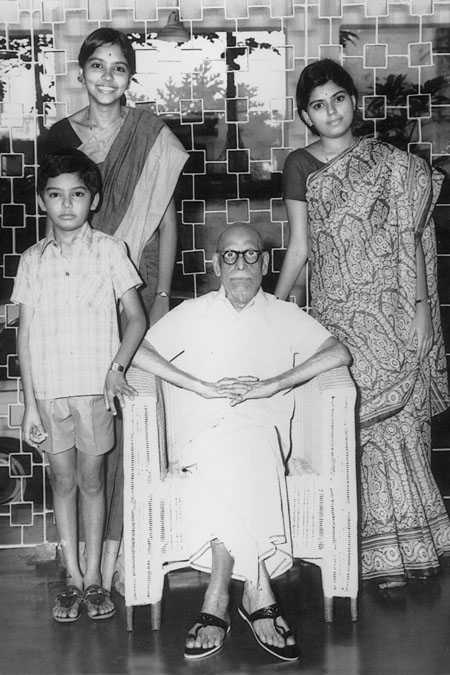
Nooyi (Top left) and her siblings with her Thatha (Grandfather).
It was Nooyi’s belief that this was the only way that an iconic company like PepsiCo could leave a lasting legacy way beyond her tenure. Towards that end, Nooyi regrouped PepsiCo’s objectives into three categories: those that nourish, those that replenish, and those that cherish.
The idea behind nourish was to feed societies in a responsible manner, encouraging consumers to make healthy and informed food choices. It meant making sure that the great taste of PepsiCo’s products did not come at the cost of people’s health. This involved tinkering with recipes of well-established and well-loved products; and despite the huge risks, Nooyi did not hesitate to walk the talk when it came down to putting the money behind her ideas. She hired scientific officers, molecular biologists, pharmacologists, computer modelers and environmental engineers to offer healthier options like diet sodas and low-calorie options, and to further innovate and market their products like oatmeal, teas and fruit juices.
Replenish was about rethinking ways to protect the environment. PepsiCo’s new R&D unit sought to cut fuel consumption, conserve water, and reduce plastic usage by incorporating higher levels of recycled plastic in soda bottles. It is initiatives such as these, spearheaded by Nooyi, that have helped PepsiCo today achieve its goal of using 100 percent renewable electricity not just in the United States, but also in several international markets around the world. In 2012, PepsiCo won the Stockholm Water Prize, the world’s top award for the conservation and protection of water resources, for saving sixteen billion liters of water in five years.
The third and final component of Nooyi’s Performance with Purpose strategy was cherish, which involved appreciating and empowering PepsiCo’s more than 250,000 employees; and allowing them to thrive and prosper. For Nooyi, it meant being accessible to every PepsiCo employee whether in the corporate office or on the factory floor, it meant taking the time to listen to employees’ stories when she traveled to PepsiCo facilities all around the world, and sometimes, it also meant writing letters to the parents and spouses of her senior executives, thanking them for sharing their children and partners respectively with PepsiCo.
It is acts such as these that make Nooyi such a rare global leader who, in the words of the former President & CEO of Starbucks, Howard Schultz, “always did the right thing for her employees and consumers.”
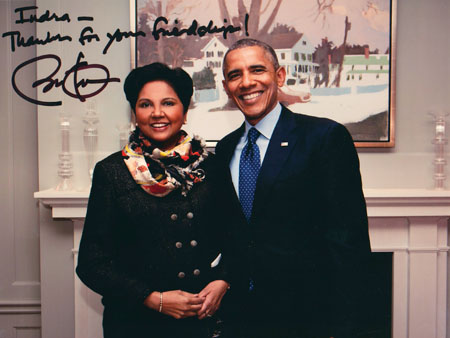 In November 2019, Indra Nooyi became the first Indian-American to be inducted into the Smithsonian National Portrait Gallery. Her portrait is unique in that it includes a picture of her parents, a picture of her husband and her daughters, a picture of a PepsiCo annual report with the words Performance with Purpose on it, and a picture of a baseball cap with Yale School of Management logo on it. Nooyi believes that it is these four things that define her—a family that keeps her grounded and a sense of purpose that propels her forward. She is who she is because of them.
In November 2019, Indra Nooyi became the first Indian-American to be inducted into the Smithsonian National Portrait Gallery. Her portrait is unique in that it includes a picture of her parents, a picture of her husband and her daughters, a picture of a PepsiCo annual report with the words Performance with Purpose on it, and a picture of a baseball cap with Yale School of Management logo on it. Nooyi believes that it is these four things that define her—a family that keeps her grounded and a sense of purpose that propels her forward. She is who she is because of them.
[Right] “Indra – thanks for your friendship,” is how President Obama signed this photo.
Going forward, she intends to work on issues of care infrastructure, paid leave, and job flexibility, so that young family builders can have children and yet continue to work. Driven by this purpose, she hopes to bring together the private sector, the federal and state governments, and the childhood education experts to create childcare systems that will relieve the stress on young people and, in turn, help women advance.
Her mother recently told her , “There are not many people like you. You must give back as much as you can. Keep on.” And that’s certainly what Indra Nooyi intends to do.
Here’s my conversation with Nooyi on her book, family and work.
Writing a book is a laborious process. In the age of TED Talks and TikTok videos, why write a book?
I never intended to write a book. I actually started writing policy papers on how to advance women in the corporate world so that there can be more women CEOs or more senior executives in the workforce. And then, during the pandemic, I noticed that it’s not just the managerial women we need to worry about. A lot of the essential workers, who are largely women, struggle because there is no care infrastructure to help them, especially in the case of single parents who have to support their families. So, I looked at these two problems instead. But people said care infrastructure is boring, nobody’s going to read about it. That’s when I decided to write a book.
This book is not a traditional memoir; it is a book filled with lessons from the arc of my life, which then informs policy on what needs to be done to help the essential workers and the managerial women—in particular, the family builders—to keep their jobs and build families at the same time.
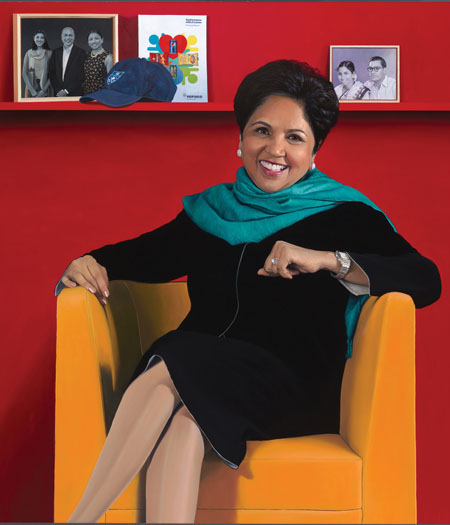
I wrote it with lessons in every chapter with focus on the working women, the essential women, and also the immigrant population. My sincere hope is that young people, especially immigrants read it; and that they read it slowly and are guided through it. Meaning, they stop at the end of the chapter and pause and say: what are the lessons, what does it mean for us? Because I always say I didn’t write the book for myself. I say I wrote it for us. Many people look at me and say you are the role model. The role model is sharing with you everything she knows. Use it to the best of your ability.
[Left] In November 2019, Indra Nooyi became the first Indian-American to be inducted into the Smithsonian National Portrait Gallery. Her portrait includes, among other things, a picture of her parents along with a picture of her husband and her daughters.
A common thread in your book has been the importance of family—a stable and sound family to give women the opportunity to thrive. And yet, the very demands of corporate America are such that they seek to dismantle the institution of family. Not intentionally, [but] inadvertently. What needs to change?
I think Covid has already changed it because of the technology that has evolved around it. We now have Zoom, Microsoft Teams and Google Meet. All these remote technologies have progressed rapidly. I think the fact that we can keep in touch with our kids through smartphones is a huge advantage. For the first time, there can actually be a work-life balance. Now you can work during the day; and when the kids come back from school, you can be home and continue working remotely too, if needed. This was not available to me. In my time, I had to travel overseas. Now, we can do a lot of business through technology. I am very optimistic about how we can balance work and family going into the future. It’s never going to be optimal. But I think if we want to deploy the best and the brightest, we need to give our women the economic and financial freedom. We must make it possible for women to enter the workforce and contribute to the betterment of the economy. I’m a big believer in this.
Don’t you think that there need to be more government-sponsored care infrastructure programs, something akin to the “anganwadis,” we used to have in India? How do we make resources accessible to women, so that they don’t quit their careers midway?
There’s got to be infrastructure by government, by communities, by societies, by states, whatever. It has to be affordable, available and high quality. They have to be made available in traditional hours and non- traditional hours. That system has got to be available if we want to deploy all the best brains in the service of the country. And I think it is the quality of the talent that is going to differentiate a great country from another.
Being an Asian female in a club of CEOs who are still all mostly white and male, what would be your advice to them so they are more welcoming of diversity, more welcoming of women in their organizations?
It’s beginning to change. When I entered PepsiCo in 1994, there were no women CEOs. In 2006, when I became CEO, there were six women CEOs. Today there are 41. That’s still only 8.5 percent of the Fortune 500. But there are more women now edging up to the top. But if we don’t give these women support structures, they won’t stay to be considered for CEOs. I think men in power have to acknowledge that women represent our single biggest talent pool. We need to elevate them not because they are women but because they are an incredible talent. If we just think of talent and not about gender and ethnicity, I think we will end up with more women and diverse people. We have to get to a point where, as the young people ascend to the top, we get increasingly blind about gender, ethnicity and background, and just focus on raw talent.
What would be your advice to women who are entering the workforce? What can they do differently to shatter the glass ceiling more easily?
I can only tell you what I did. Focus on competence and the quality of your output. Draw attention to the fact that you are a professional par excellence. Don’t focus on drawing attention to the fact that you are a woman professional. Just say that I’m a professional, I know what I’m doing, I know the stuff cold, and I’m going to contribute to the betterment of the organization. If you put the company before everything else and just brutally focus on your competence, I think you’ll move ahead. Very often we forget that. Just focus maniacally that way, based on competence, and you’ll be amazed at how many doors open for you. That’s what I did.
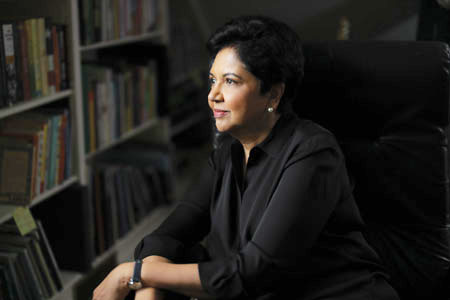
You’ve talked about your mother asking you to leave your crown in the garage the day you became the President of PepsiCo. That simple incident speaks to the mother-daughter relationship in most Indian families. However, to American kids of today’s generation, that may sound like a mother who is not supportive or celebratory of her daughter’s achievements and corporate success. What do you think are some lessons from your mom that you wish kids of today’s generation or even, corporate America for that matter, would embrace?
I think it was a lesson in power and humility. What she was saying was you can have all the power outside the home but when you come home, both you and your husband are equal partners in raising your kids. Because nobody else can do it. So, you have to figure out how to put on your humility crown when you come in, not your power crown. Nobody at home works for you. So, I could either look at my mom’s comment as: why did she put a damper on me or is there a more profound lesson in what she said? At that time, I was irritated but later I realized the value of what she was teaching me. And I think that’s what I am focused on—the whole chain of power and humility.
What values are sacred to you not just as CEO of this big conglomerate, but as a human being that you would want to pass on to your kids and grandkids?
Curiosity, lifelong learning, integrity and not forgetting that family, friends and faith have to come before everything else. At the end of the day, that’s what roots you, that’s what centers you and keeps you whole.
Deepa Agarwal is part of a Peabody Award-winning team at CNN International where she is a Planning Producer and was formerly a full time Editorial Producer.
Enjoyed reading Khabar magazine? Subscribe to Khabar and get a full digital copy of this Indian-American community magazine.
blog comments powered by Disqus










